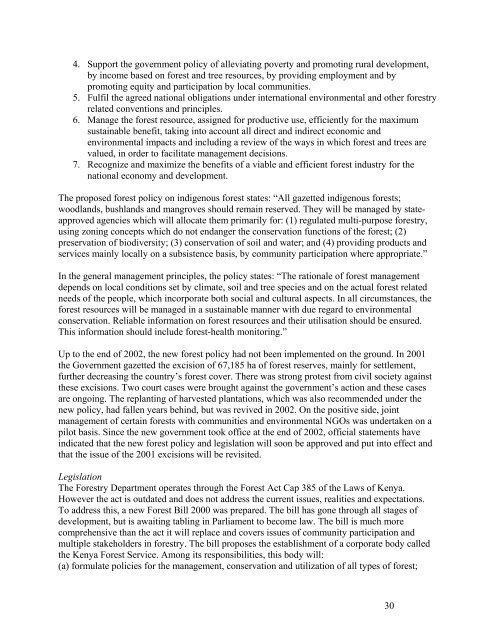Eastern Arc Mountains and Coastal Forests of Tanzania and Kenya ...
Eastern Arc Mountains and Coastal Forests of Tanzania and Kenya ...
Eastern Arc Mountains and Coastal Forests of Tanzania and Kenya ...
Create successful ePaper yourself
Turn your PDF publications into a flip-book with our unique Google optimized e-Paper software.
4. Support the government policy <strong>of</strong> alleviating poverty <strong>and</strong> promoting rural development,by income based on forest <strong>and</strong> tree resources, by providing employment <strong>and</strong> bypromoting equity <strong>and</strong> participation by local communities.5. Fulfil the agreed national obligations under international environmental <strong>and</strong> other forestryrelated conventions <strong>and</strong> principles.6. Manage the forest resource, assigned for productive use, efficiently for the maximumsustainable benefit, taking into account all direct <strong>and</strong> indirect economic <strong>and</strong>environmental impacts <strong>and</strong> including a review <strong>of</strong> the ways in which forest <strong>and</strong> trees arevalued, in order to facilitate management decisions.7. Recognize <strong>and</strong> maximize the benefits <strong>of</strong> a viable <strong>and</strong> efficient forest industry for thenational economy <strong>and</strong> development.The proposed forest policy on indigenous forest states: “All gazetted indigenous forests;woodl<strong>and</strong>s, bushl<strong>and</strong>s <strong>and</strong> mangroves should remain reserved. They will be managed by stateapprovedagencies which will allocate them primarily for: (1) regulated multi-purpose forestry,using zoning concepts which do not endanger the conservation functions <strong>of</strong> the forest; (2)preservation <strong>of</strong> biodiversity; (3) conservation <strong>of</strong> soil <strong>and</strong> water; <strong>and</strong> (4) providing products <strong>and</strong>services mainly locally on a subsistence basis, by community participation where appropriate.”In the general management principles, the policy states: “The rationale <strong>of</strong> forest managementdepends on local conditions set by climate, soil <strong>and</strong> tree species <strong>and</strong> on the actual forest relatedneeds <strong>of</strong> the people, which incorporate both social <strong>and</strong> cultural aspects. In all circumstances, theforest resources will be managed in a sustainable manner with due regard to environmentalconservation. Reliable information on forest resources <strong>and</strong> their utilisation should be ensured.This information should include forest-health monitoring.”Up to the end <strong>of</strong> 2002, the new forest policy had not been implemented on the ground. In 2001the Government gazetted the excision <strong>of</strong> 67,185 ha <strong>of</strong> forest reserves, mainly for settlement,further decreasing the country’s forest cover. There was strong protest from civil society againstthese excisions. Two court cases were brought against the government’s action <strong>and</strong> these casesare ongoing. The replanting <strong>of</strong> harvested plantations, which was also recommended under thenew policy, had fallen years behind, but was revived in 2002. On the positive side, jointmanagement <strong>of</strong> certain forests with communities <strong>and</strong> environmental NGOs was undertaken on apilot basis. Since the new government took <strong>of</strong>fice at the end <strong>of</strong> 2002, <strong>of</strong>ficial statements haveindicated that the new forest policy <strong>and</strong> legislation will soon be approved <strong>and</strong> put into effect <strong>and</strong>that the issue <strong>of</strong> the 2001 excisions will be revisited.LegislationThe Forestry Department operates through the Forest Act Cap 385 <strong>of</strong> the Laws <strong>of</strong> <strong>Kenya</strong>.However the act is outdated <strong>and</strong> does not address the current issues, realities <strong>and</strong> expectations.To address this, a new Forest Bill 2000 was prepared. The bill has gone through all stages <strong>of</strong>development, but is awaiting tabling in Parliament to become law. The bill is much morecomprehensive than the act it will replace <strong>and</strong> covers issues <strong>of</strong> community participation <strong>and</strong>multiple stakeholders in forestry. The bill proposes the establishment <strong>of</strong> a corporate body calledthe <strong>Kenya</strong> Forest Service. Among its responsibilities, this body will:(a) formulate policies for the management, conservation <strong>and</strong> utilization <strong>of</strong> all types <strong>of</strong> forest;30
















